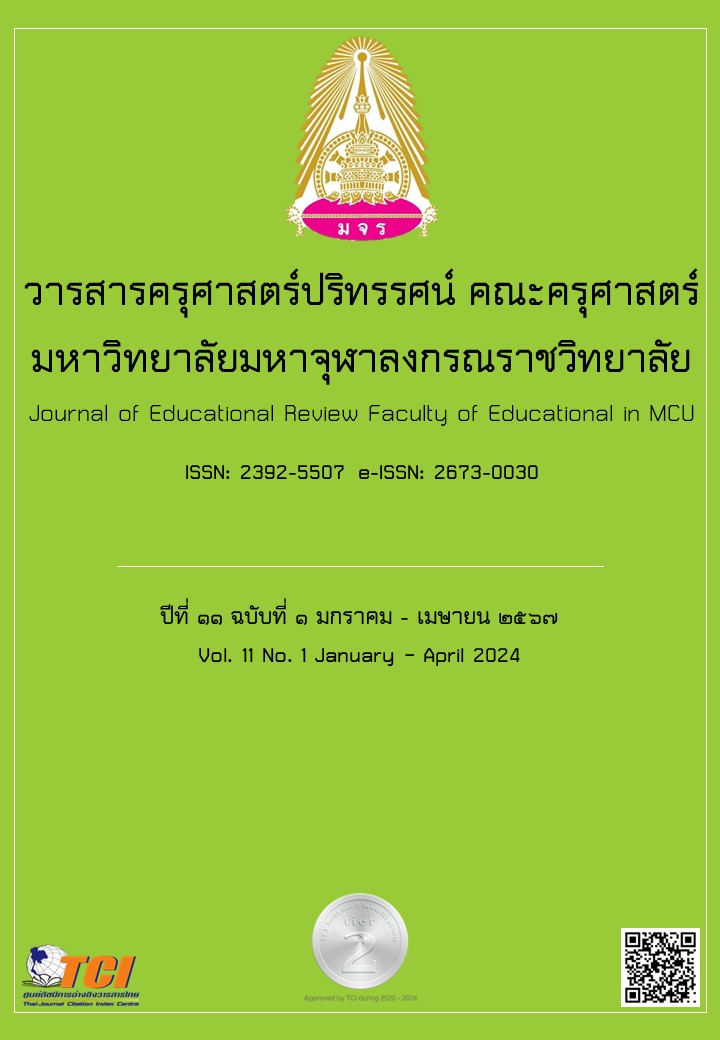SCHOOL ADMINISTRATIVE TO ENHANCE THE KINDERGARTEN TEACHER’S COMPETENCY BY PROVIDING AN ACTIVE LEARNING EXPERIENCE FOR THE DEVELOPMENT OF SCIENCE PROCESSING SKILLS FOR KINDERGARTEN STUDENTS UNDER SARABURI PRIMARY EDUCATIONAL SERVICE AREA OFFICE 1
Main Article Content
Abstract
The objective of this research article was to study school administration that promotes kindergarten teachers' competency in organizing active learning experiences to develop kindergarten students’ science processing skills under the Saraburi Primary Educational Service Area Office 1. It was a combined methods research with a 3-step research method: Step 1: Studying the needs for development that promotes the competency of kindergarten teachers in organizing active learning experiences to develop kindergarten students’ science processing skills under the Saraburi Primary Educational Service Area Office 1. The questionnaire was used, the sample group was 92 kindergarten teachers in the school and interviews with 9 key informants. Step 2: Developing the model by interviewing 5 experts. Steps 3: Trialing and evaluating the model from a sample of 6 people selected purposively. Analyzing quantitative data with basic statistics such as percentages, averages, and standard deviations and qualitative data analysis using content analysis. The research results found that the school administration model promoted the competency of kindergarten teachers in organizing active learning experiences to develop the science processing skills of kindergarten students under the Saraburi Primary Educational Service Area Office 1, it consisted of 3 components; Component 1: organizing English learning for communication according to the international English proficiency standard framework, 4 competencies, consisting of
1) competency in organizing experiences had 7 indicators, 2) Competency in knowledge development had 7 indicators, 3) Competency in human relations had 7 indicators, 4) Competency in participation had 7 indicators. Component 2: The K-POLC management process consisted of 1) Knowledge had 5 indicators, 2) Planning had 5 indicators, 3) Organizing had 5 indicators, 4) Leading had 5 indicators, 5) Controlling had 5 indicators. Component 3: Scientific processing skills, consisting of 6 skills; 1) observation skills, 2) measurement skills, 3) classification skills, 4) organization and interpreting data skills, 5) data annotation skills, and 6) forecasting skills. The results of evaluating the feasibility and usefulness of a school administration model that promoted kindergarten teachers' competency in organizing active learning experiences to develop kindergarten students’ science processing skills under the Saraburi Primary Educational Service Area Office 1, overall, it was at the highest level of feasibility and usefulness.
Article Details

This work is licensed under a Creative Commons Attribution-NonCommercial-NoDerivatives 4.0 International License.
ทัศนะและความคิดเห็นที่ปรากฏในบทความในวารสารฉบับนี้ถือเป็นความรับผิดชอบของผู้เขียนบทความนั้นเพียงผู้เดียว และไม่ถือเป็นทัศนะและความรับผิดชอบของกองบรรณาธิการ
กองบรรณาธิการขอสงวนสิทธิ์ในการคัดเลือกบทความลงตีพิมพ์และจะแจ้งให้เจ้าของบทความทราบหลังจากผู้ประเมินบทความตรวจอ่านบทความแล้ว
ต้นฉบับที่ได้รับการตีพิมพ์ในวารสารครุศาสตร์ปริทรรศน์ คณะครุศาสตร์ มหาวิทยาลัยมหาจุฬาลงกรณราชวิทยาลัย ถือเป็นกรรมสิทธิ์ของคณะครุศาสตร์ มหาวิทยาลัยมหาจุฬาลงกรณราชวิทยาลัย ห้ามนำข้อความทั้งหมดหรือบางส่วนไปพิมพ์ซ้ำ เว้นเสียแต่ว่าจะได้รับอนุญาตจากมหาวิทยาลัยฯ เป็นลายลักษณ์อักษร
References
กระทรวงศึกษาธิการ. (2546). พระราชบัญญัติการศึกษาแห่งชาติ พุทธศักราช 2542 แก้ไขเพิ่มเติม (ฉบับที่ 2) พ.ศ. 2545. กรุงเทพมหานคร: โรงพิมพ์คุรุสภาลาดพร้าว.
กระทรวงศึกษาธิการ. (2553). พระราชบัญญัติการศึกษาแห่งชาติ พ.ศ. 2542 และที่แก้ไขเพิ่มเติม (ฉบับที่ 2) พ.ศ.2545. กรุงเทพมหานคร: โรงพิมพ์คุรุสภาลาดพร้าว.
กระทรวงศึกษาธิการ. (2557). นโยบายด้านการศึกษารัฐมนตรีว่าการกระทรวงศึกษาธิการ. แหล่งที่มา http://www.bic.moe.go.th/th/index.php. สืบค้นเมื่อ 1 ก.พ. 2562.
กันตวรรณ มีสมสาร. (2560). การพัฒนาสมรรถนะด้านการจัดการเรียนรู้ของครูปฐมวัยในศตวรรษที่ 21.วารสารวไลยองกรณ์ปริทัศน์. 7(2). 45-56.
เกรียงศักดิ์ เจริญวงศ์ศักดิ์. (2551). ทักษะทางสังคม พื้นฐานการอยู่ร่วมอย่างมีความสุข. แม่และเด็ก. 31(432). 102-103
.
ฉัตรชัย หวังมีจงมี. (2560). สมรรถนะของครูไทยในศตวรรษที่ 21 : ปรับการเรียนเปลี่ยนสมรรถนะ. Journal of HRintelligence. 12(2). 47-63.
เทพกัญญา พรหมขัติแก้ว. (2554). ธรรมชาติการเรียนรู้ของเด็กปฐมวัยกับการเรียนรู้วิทยาศาสตร์ คณิตศาสตร์ และเทคโนโลยี. สถาบันส่งเสริมการสอนวิทยาศาสตร์และเทคโนโลยี. 40(174). 32-35.
นันทกา วารินิน. (2557). รูปแบบการพัฒนาสมรรถนะการจัดการเรียนรู้ของครูสำหรับโรงเรียนสังกัดสำนักงานเขตพื้นที่การศึกษาประถมศึกษากำแพงเพชร เขต 2. ดุษฎีนิพนธ์ครุศาสตรดุษฎีบัณฑิต. มหาวิทยาลัยราชภัฏนครสวรรค์.
นิศารัตน์ แซ่ซ้ง. (2552). ผลของการจัดประสบการณ์การเรียนรู้แบบโครงการเพื่อพัฒนาทักษะกระบวนการ วิทยาศาสตร์สำหรับเด็กปฐมวัย. วิทยานิพนธ์การศึกษามหาบัณฑิต. มหาวิทยาลัยราชภัฏลำปาง.
ยศวีร์ สายฟ้า. (2551). เอกสารประกอบการอบรม เรื่อง “สอนวิทย์-คณิตในระดับปฐมวัยอย่างไรให้สนุกและได้มาตรฐาน” สถาบันส่งเสริมการสอนวิทยาศาสตร์และเทคโนโลยี มาตรฐานครูวิทยาศาสตร์และเทคโนโลยี. กรุงเทพมหานคร: โรงพิมพ์คุรุสภาลาดพร้าว.
วิจารณ์ พานิช. (2556). วิธีสร้างการเรียนรู้เพื่อศิษย์ในศตวรรษที่ 21. กรุงเทพมหานคร: ตถาตาพับบลิเคชัน.
สถาบันส่งเสริมการสอนวิทยาศาสตร์และเทคโนโลยี. (2554). คู่มือวัดผลประเมินผลวิทยาศาสตร์. กรุงเทพมหานคร: สถาบันส่งเสริมการสอนวิทยาศาสตร์และเทคโนโลยี.
สำนักงานเขตพื้นที่การศึกษาประถมศึกษาสระบุรี เขต 1. (2562). แผนยุทธศาสตร์และแผนปฏิบัติการ. แหล่งที่มา https://srb1.go.th/?page_id=4081 สืบค้นเมื่อ 2 มี.ค. 2566.
สำนักงานเขตพื้นที่การศึกษาประถมศึกษาสระบุรี เขต 1. (2564). การเปิดเผยข้อมูลสาธารณะ. แหล่งที่มา https://srb1.go.th/?cat=14 สืบค้นเมื่อ 2 มี.ค. 2566.
สำนักงานคณะกรรมการการศึกษาขั้นพื้นฐาน. (2562). แนวทางการนิเทศเพื่อพัฒนาและส่งเสริมการจัดการเรียนรู้เชิงรุก (Active Learning) ตามนโนบายลดเวลาเรียน เพิ่มเวลารู้. กรุงเทพมหานคร: สำนักงานคณะกรรมการการศึกษาขั้นพื้นฐาน.
สำนักงานคณะกรรมการส่งเสริมสวัสดิการและสวัสดิภาพครูและบุคลากรทางการศึกษา. (2550). ครูของแผ่นดิน : ประมวลพระบรมราโชวาท พระบาทสมเด็จพระเจ้าอยู่หัว ด้านการศึกษา. กรุงเทพมหานคร: สำนักงานคณะกรรมการส่งเสริมสวัสดิการและสวัสดิภาพครูและบุคลากรทางการศึกษา.
สิริกาญจน์ ธนวุฒิพรพินิต และคณะ. (2566). รูปแบบการบริหารการจัดการเรียนรู้ภาษาอังกฤษแนวใหม่ตามกรอบอ้างอิงความสามารถทางภาษาของสหภาพยุโรป (CEFR) ระดับมัธยมศึกษา เชื่อมโยงกับการประกันคุณภาพการศึกษา. วารสารครุศาสตร์ปริทรรศน์ คณะครุศาสตร์ มหาวิทยาลัยมหาจุฬาลงกรณราชวิทยาลัย. 10(3). 351-362.
อัญชลี ไสยวรรณ. (2548). การพัฒนารูปแบบการเรียนการสอนทักษะการคิดแสวงหาความรู้สำหรับเด็กปฐมวัย. ดุษฎีนิพนธ์การศึกษาดุษฎีบัณฑิต. มหาวิทยาลัยศรีนครินทรวิโรฒ.
Keeves, P. J. (1988). Model and Model Building Education Research, Methodology and Measurement: An International Handbook. Oxford: Pergamon Press.
Krejcie, R.V. & Morgan, D.W. (1970). Determining Sample Size for Research Activities. Educational and Psychological Measurement. 30(3). 607-610.
Likert, Rensis. (1932). The Method of Constructing and Attitude Scale. In Reading in Fishbeic, M (Ed.), Attitude Theory and Measurement. New York: Wiley & Son.
Visser, A. (2000). Chronic Diseases, Aging, and Dementia: Implications for Patient Education and Counselling (Book Reviews). Patient Education and Counselling. 39. 293- 309.


